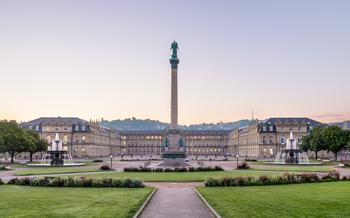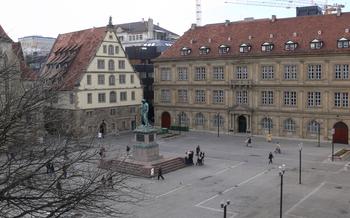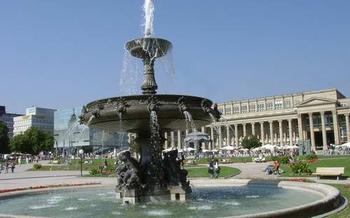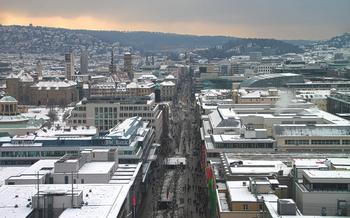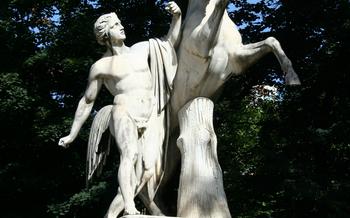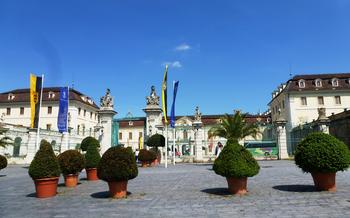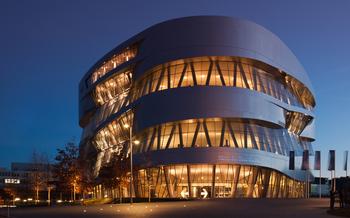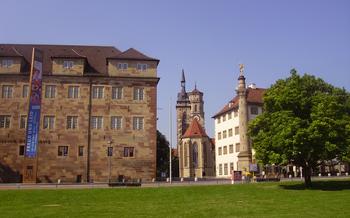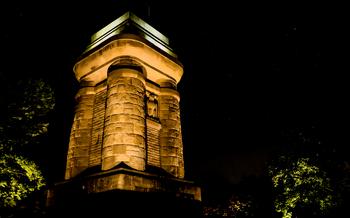
The Württemberg Mausoleum
- Historical Significance
- Location and Accessibility:
- Architectural Design
- Interior Features
- Royal Burials
- Guided Tours
- Opening Hours and Admission
- Accessibility for Visitors with Disabilities
- Photography and Videography
- Souvenirs and Gifts
- Nearby Attractions
- Food and Drink Options
- Accommodations
- Events and Exhibitions
- Insider Tip: Unveiling the Secret Passage
Historical Significance
The Württemberg Mausoleum, nestled in the heart of Stuttgart, Germany, stands as a testament to the rich history and legacy of the Württemberg dynasty. Constructed between 1820 and 1824 under the reign of King Wilhelm I, this neoclassical masterpiece serves as the final resting place for Württemberg's monarchs and their families.
The mausoleum's architectural design, inspired by ancient Greek temples, exudes grandeur and solemnity. Its symmetrical facade, adorned with intricate carvings and sculptures, reflects the artistic and cultural influences of the period. The central dome, a symbol of eternity, rises majestically above the structure, emphasizing its significance as a royal burial site.
Within the mausoleum's hallowed halls, visitors can learn about the lives and reigns of the Württemberg monarchs who shaped the kingdom's history. From King Friedrich I, who ascended to the throne in 1797, to King Wilhelm II, who ruled during the tumultuous years of World War I, each monarch's story unfolds through artifacts, portraits, and inscriptions.
The mausoleum has witnessed countless ceremonies and events that have left an indelible mark on Württemberg's history. From royal weddings to state funerals, these occasions have transformed the mausoleum into a stage where the drama of power, tradition, and remembrance has played out over the centuries.
Location and Accessibility:
Stuttgart, the vibrant capital of Baden-Württemberg in southern Germany, is home to a plethora of cultural and historical treasures, including the awe-inspiring Württemberg Mausoleum. This grand neoclassical edifice stands majestically atop Württemberg Hill, overlooking the city and offering panoramic vistas that will leave you breathless.
To reach the mausoleum, you can embark on a leisurely stroll from the city center, taking in the charming streets and landmarks along the way. Alternatively, you can hop on bus routes 42 or 44, which conveniently stop right outside the mausoleum's gates. If you prefer the convenience of driving, there are ample parking spaces available nearby, ensuring a hassle-free visit.
Architectural Design
The Württemberg Mausoleum stands as a testament to the architectural brilliance of its time, showcasing a harmonious blend of neoclassical and historical influences. Constructed primarily using sandstone and marble, the mausoleum exudes an aura of elegance and grandeur. Its symmetrical design, reminiscent of ancient Greek temples, features a central dome that dominates the skyline, symbolizing the eternal nature of the resting place within. The exterior is adorned with intricate carvings, sculptures, and decorative elements, each contributing to the mausoleum's rich visual appeal. These embellishments depict scenes from mythology, history, and the lives of the Württemberg monarchs, adding depth and meaning to the mausoleum's architectural narrative.
Interior Features
The Württemberg Mausoleum boasts an awe-inspiring interior that matches its grand exterior. Step inside, and you'll be greeted by a central rotunda, the heart of the mausoleum. Its majestic dome, adorned with intricate frescoes and gold leaf, draws your gaze upwards, creating a sense of wonder and reverence. Surrounding the rotunda are several chambers, each dedicated to a different Württemberg monarch or family member.
The opulence of the mausoleum's interior is evident in the lavish use of materials such as marble, gold, and precious stones. The walls are lined with marble panels, creating a gleaming and polished effect. Gold accents and intricate carvings add a touch of grandeur and elegance to the space.
Notable features within the mausoleum include the magnificent sarcophagi of the Württemberg monarchs, each crafted from a single block of marble and adorned with intricate sculptures and inscriptions. These sarcophagi serve as a testament to the skill and artistry of the craftsmen who created them.
The mausoleum also houses a collection of paintings, sculptures, and other artwork that depict scenes from the lives of the Württemberg monarchs and their families. These works of art provide a glimpse into their history and legacy, adding a personal touch to the mausoleum's interior.
Royal Burials
The Württemberg Mausoleum serves as the final resting place for several notable monarchs of the Kingdom of Württemberg. Among them lie King Wilhelm I, who reigned from 1816 to 1864, and his wife, Queen Katharina. Wilhelm I is remembered for his role in modernizing Württemberg, introducing reforms in education, infrastructure, and the military. Queen Katharina, a beloved figure, was known for her philanthropic efforts and her dedication to the welfare of her people.
Other notable burials include King Wilhelm II, who succeeded his father in 1864, and his wife, Queen Charlotte. Wilhelm II continued the modernization efforts of his father and oversaw the expansion of Württemberg's industrial base. Queen Charlotte was a patron of the arts and culture, supporting various artistic and educational institutions.
The mausoleum also holds the remains of King Karl I, who reigned during the turbulent period of World War I and the German Revolution. Karl I abdicated in 1918, marking the end of the Württemberg monarchy.
Each of these monarchs played a significant role in shaping the history and legacy of the Kingdom of Württemberg. Their burials in the mausoleum serve as a testament to their contributions and the enduring legacy of the Württemberg dynasty.
Guided Tours
The Württemberg Mausoleum offers guided tours that provide visitors with an in-depth exploration of its history, architecture, and significance. These tours are led by knowledgeable and experienced guides who bring the mausoleum's stories to life.
Guided tours typically last for around 45 minutes and cover various aspects of the mausoleum, including its construction, architectural features, and the lives of the Württemberg monarchs buried there. Visitors will have the opportunity to learn about the symbolism and iconography found throughout the mausoleum, as well as the fascinating tales of the royal family.
Tours are offered at regular intervals throughout the day, and visitors can book them in advance or on-site at the mausoleum's ticket office. Prices for guided tours may vary depending on the group size and any special arrangements.
One of the highlights of a guided tour is the access to restricted areas of the mausoleum, such as the crypt where the Württemberg monarchs are buried. Visitors will be able to see the elaborate sarcophagi and learn about the rituals and traditions associated with the royal burials.
If you want to gain a deeper understanding of the Württemberg Mausoleum and its history, a guided tour is highly recommended. The knowledgeable guides will provide insights and anecdotes that will enhance your appreciation of this magnificent building.
Opening Hours and Admission
The Württemberg Mausoleum welcomes visitors from Tuesday to Sunday, inviting them to delve into its rich history and architectural splendor. Its doors open at 10:00 AM, allowing ample time to explore the mausoleum's captivating interior and pay homage to the Württemberg monarchs laid to rest within. The mausoleum closes its doors at 5:00 PM, ensuring that visitors have a leisurely experience without feeling rushed.
Admission to the mausoleum is subject to a modest fee, which contributes to the preservation and upkeep of this historic landmark. Adults are required to pay a standard admission fee, while children and Jugendliche enjoy a discounted rate. Concessions are also available for students and seniors, allowing everyone the opportunity to experience the allure of the Württemberg Mausoleum.
To ensure a seamless visit, visitors can purchase tickets on-site at the mausoleum's ticket office. The friendly and knowledgeable staff is always ready to assist with any inquiries and provide additional information. The mausoleum also offers free admission on select days throughout the year, providing an excellent opportunity for budget-conscious travelers or those seeking a spontaneous cultural immersion. These special free admission days are announced in advance, so visitors are encouraged to check the mausoleum's website or social media pages for updates.
Whether you're a history buff, an architecture enthusiast, or simply seeking a serene and contemplative space, the Württemberg Mausoleum offers an enriching experience for all. Its accessible opening hours, reasonable admission fees, and free admission days make it a must-visit destination for anyone exploring the captivating city of Stuttgart.
Accessibility for Visitors with Disabilities
The Württemberg Mausoleum is committed to providing an accessible and inclusive experience for visitors with disabilities. The mausoleum is wheelchair accessible, with ramps and elevators available to all levels of the building. Visitors with visual impairments can request audio guides or tactile maps of the mausoleum. The staff is also trained to assist visitors with disabilities and can provide any necessary assistance or accommodations.
Visitors with disabilities can enjoy a comfortable and fulfilling visit to the Württemberg Mausoleum. The accessible features and the supportive staff ensure that everyone can learn about and appreciate the history and beauty of this iconic landmark.
Tips for Visitors with Disabilities
- Contact the mausoleum in advance to inquire about any specific accessibility needs or to request assistance.
- Arrive early to avoid crowds and have ample time to explore the mausoleum at your own pace.
- Take advantage of the audio guides or tactile maps to learn more about the mausoleum's history and architecture.
- Feel free to ask the staff for assistance or directions at any time.
- Be prepared for some uneven surfaces or narrow passages, as the mausoleum is a historical building.
Photography and Videography
The Württemberg Mausoleum is a popular destination for photography enthusiasts, offering a range of captivating subjects to capture. Visitors are permitted to take photos and videos for personal use, but certain guidelines must be followed. Flash photography and the use of tripods and selfie sticks are not allowed inside the mausoleum, as these may disrupt the serene atmosphere and damage the delicate interior. It is important to respect the privacy of other visitors and refrain from taking photos or videos of them without their consent. When capturing the grandeur of the mausoleum's architecture and artwork, photographers should be mindful of the lighting conditions, as the natural light streaming through the windows creates beautiful effects throughout the day. For those seeking to capture the essence of the mausoleum's history and symbolism, it is recommended to explore the surrounding park and gardens, where they can find interesting angles and perspectives that convey the mausoleum's significance within the wider landscape.
Souvenirs and Gifts
The Württemberg Mausoleum offers a small selection of souvenirs and gifts for visitors to remember their visit. These items can be purchased at the information desk located inside the mausoleum. The available souvenirs include postcards featuring images of the mausoleum and its surroundings, books on the history of the Württemberg dynasty, and replicas of artifacts found within the mausoleum. If you're looking for a unique and meaningful souvenir, consider purchasing a piece of jewelry inspired by the mausoleum's architecture or symbolism. These items make for memorable keepsakes that will remind you of your visit to this historic site.
Nearby Attractions
The Württemberg Mausoleum is conveniently situated in the heart of Stuttgart, surrounded by a wealth of historical and cultural attractions. To enhance your visit, consider exploring some of these nearby destinations:
-
Wilhelma Zoo and Botanical Garden: Just a short walk from the mausoleum, discover a unique combination of wildlife and botanical wonders. With over 1,100 animal species and a stunning collection of plants from around the world, Wilhelma offers a delightful experience for nature enthusiasts.
-
Mercedes-Benz Museum: Immerse yourself in the history of automotive innovation at the Mercedes-Benz Museum, located a short drive from the mausoleum. Explore a fascinating collection of classic and modern Mercedes vehicles, tracing the evolution of the automobile and its impact on our world.
-
Stuttgart State Museum: Delve into the rich history and culture of Württemberg and the surrounding region at the Stuttgart State Museum. With exhibits ranging from archaeology to art, this museum offers a comprehensive insight into the heritage of southwestern Germany.
-
Hohenheim Palace and Gardens: Escape the city bustle at Hohenheim Palace, a beautiful baroque palace surrounded by enchanting gardens. Stroll through the sprawling grounds, admire the palace's impressive architecture, and soak in the serene atmosphere.
-
Fernsehturm Stuttgart: For a breathtaking panoramic view of Stuttgart and the surrounding region, ascend the Fernsehturm Stuttgart, a towering television tower located a short distance from the mausoleum. Enjoy a meal at the revolving restaurant at the summit for an unforgettable dining experience.
These nearby attractions provide an opportunity to delve deeper into Stuttgart's cultural and historical treasures, creating a comprehensive and enriching travel experience.
Food and Drink Options
After exploring the rich history and architecture of the Württemberg Mausoleum, visitors may want to grab a bite to eat or enjoy a refreshing drink. Fortunately, there are several food and drink options located within walking distance of the mausoleum.
For a quick and casual meal, visitors can head to the nearby Café Maultasche, which serves traditional Swabian dishes such as the namesake maultaschen (stuffed pasta pockets) and Käsespätzle (cheese noodles). Another popular option is the Weinstube am Schlossgarten, which offers a wide selection of German wines and hearty dishes like schnitzel and bratwurst.
For a more upscale dining experience, visitors can try the nearby Restaurant Schlossgarten, which offers a seasonal menu of modern European cuisine with a focus on regional ingredients. For those with a sweet tooth, the Eiscafé Venezia is a must-visit, serving delicious Italian-style gelato and sorbet.
No matter what your taste or budget, you're sure to find something to satisfy your hunger and thirst near the Württemberg Mausoleum.
Accommodations
For those seeking a comfortable and convenient stay near the Württemberg Mausoleum, there are several hotels and accommodations to choose from. The nearby Maritim Hotel Stuttgart offers elegant rooms, modern amenities, and a prime location just a short walk from the mausoleum. Visitors can enjoy stunning city views from the hotel's rooftop terrace and indulge in delicious cuisine at its on-site restaurant.
Another recommended option is the Hotel am Schlossgarten, situated within walking distance of the mausoleum and the picturesque Schlossgarten park. This charming hotel offers cozy rooms, a tranquil atmosphere, and a complimentary breakfast buffet.
For budget-conscious travelers, the A&O Stuttgart City hostel provides affordable dormitory-style accommodations and private rooms. The hostel's central location and vibrant atmosphere make it a popular choice for backpackers and young travelers.
When booking accommodations, it's advisable to consider factors such as budget, preferred amenities, and proximity to the mausoleum. Online platforms like Booking.com or Tripadvisor can be useful for comparing prices, reading reviews, and making reservations.
Events and Exhibitions
The Württemberg Mausoleum occasionally hosts special events, exhibitions, or concerts that offer visitors a unique and immersive experience. These events may include historical reenactments, guided tours with expert historians, or musical performances inspired by the mausoleum's rich history. Visitors can check the mausoleum's official website or social media pages for up-to-date information on upcoming events.
One notable event held annually is the "Night of the Mausoleum," where visitors can explore the mausoleum after dark, illuminated by candlelight. This atmospheric event allows visitors to experience the mausoleum in a new and eerie light, while learning about its history and significance.
Insider Tip: Unveiling the Secret Passage
Beneath the grand facade of the Württemberg Mausoleum lies a hidden gem—a secret passageway concealed within its depths. Whispers of its existence have intrigued visitors for generations, and those who dare to explore its mysteries will be rewarded with a unique perspective on the mausoleum's history.
To find the passage, seek out the inconspicuous door tucked away in a secluded corner of the mausoleum's lower level. Once inside, follow the dimly lit corridor as it winds its way through the building's foundations. The walls are lined with ancient artifacts and forgotten relics, creating an eerie and captivating atmosphere.
As you delve deeper into the passage, you'll encounter a series of hidden chambers and secret rooms, each with its own intriguing story to tell. Discover the forgotten resting places of royal family members, uncover hidden treasures, and learn about the clandestine activities that took place within these hidden walls.
While exploring the secret passage, be sure to tread carefully and show respect for the sacred nature of the mausoleum. Remember, you are walking through the shadows of history, where the echoes of the past still linger. Embrace the mystery and let your imagination run wild as you uncover the secrets of the Württemberg Mausoleum.
